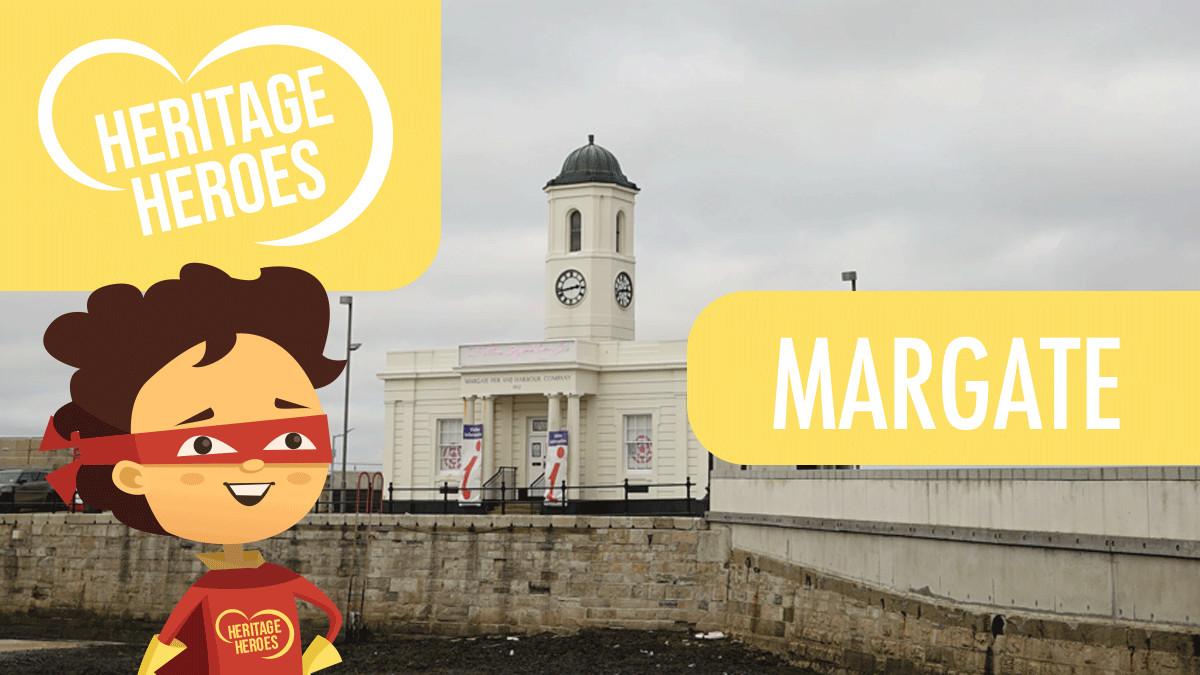Wherever you live, there’s treasure to be discovered! Not just gold and gems, but stories of buildings, locations and people.
Our heritage is a great wealth… and it’s all around us.
Sometimes standing proud in the open air, sometimes hidden behind some bushes.
To help find it, we asked for your help and to become Heritage Heroes.

HERITAGE HEROES. AN INSPIRING AUDIO PRODUCTION FOR FUN KIDS. MADE POSSIBLE WITH THE NATIONAL LOTTERY HERITAGE FUND, WITH THANKS TO NATIONAL LOTTERY PLAYERS.

Margate is a popular seaside town on the north coast of Kent. It has both a long maritime history and is particularly famous for being a well-loved tourist attraction. The beach was one of the things lots of you told us you liked!
You said…
- “The beach is my favourite thing about Margate. I really like making sandcastles.“
Margate Railway Station
We arrived at Margate Station, so where better to start?

One of the things Margate has relied on for many years is tourism. Whether sea bathing for health or a donkey ride on the beach, all those visitors needed a way to travel to Margate, and before the advent of the motorway, that was by boat and by train.
The first railway to reach Margate was the South Eastern Railway in 1846, followed by the London Chatham & Dover Railway in 1863. When these railways were amalgamated into the Southern Railway in 1923, a little rationalisation of all the lines was undertaken, including the building of a new Margate station which opened in 1926.
It was designed by Edwin Maxwell Fry and built in a ‘monumental classical style’ using brown brick with a stone dressing and a hipped tiled roof.

Did you know that the station once featured in the TV show ‘Only Fools and Horses’?
When you’re at the station, have a look out for an old water tower that would have stored water to replenish the steam locomotives.

Just imagine in Victorian times, all the people getting off the train for their holidays, walking into town with their luggage to a boarding house for a week’s holiday.
Here’s a little more about Margate’s history…
A romp through Margate’s history
Way back way in time, Margate was known as “Meregate” becoming “Margate” in around the year 1300. The name’s thought to refer to a pool gate or gap in a cliff where pools of water are found, often allowing swimmers to jump in.
Margate is actually on an island called Thanet, but the River Wantsum is no longer very wide, so you wouldn’t know you were on an island. Around the Isle of Thanet, the cliffs are chalk, which is great for finding fossils within, as we will hear about later…

Looking at the seaside town today, it might be hard to imagine but there was once a famous battle here in March 1387. This was a period known as the Hundred Years’ War and there was a series of armed conflicts between England and France.
Despite the battle being named after Margate, very little actually happened near the town. The battle was named after Margate as this was where the English fleet of 51 vessels was anchored when a French fleet of around 300 vessels was spotted. The English gave chase and defeated the French on 25th March 1387 off the coast of the Netherlands.
When you’re on the beach, have a look out to see and think what it must have been like with hundreds of boats firing on each other!

In later years, Margate was a much quieter place to live and visit, and it became a traditional holiday destination for Londoners who were drawn to its sandy beaches.
In the late 18th century, it was chosen by the physician John Coakley Lettsom as the place where he would build the Royal Sea Bathing Hospital on Canterbury Road which pioneered the use of open-air treatment for patients with certain lung illnesses. The hospital building still exists, although today are apartments for people to live in.

The Shell Grotto
Let’s explore our first Heritage Hero Hotspot – it’s the Shell Grotto… on Grotto Hill!

Discovered by chance in 1835, the chalk walls of the subterranean Shell Grotto are studded with 4.6 million shells, creating a magical mosaic of patterns and symbols. As our Heritage Hero mentioned, we don’t know who built this amazing place or why but since the first paying customers descended the chalk stairway in 1838, debate has raged about its origins.
Some think it was an ancient temple, others believe it was the meeting place for a secret society. It could just be a Victorian Folly, a way of rich people showing off how much money they had or to display their finds from around the world.

At first glance, the Grotto’s design only adds to the confusion, with humble cockles, whelks, mussels and oysters creating a swirling profusion of patterns and symbols. You can see all sorts of things in the patterns… trees, gods and goddesses, and something that very much looks like an altar.
Most of the 4.6m shells would have been sourced locally, but some are from as far away as Bournemouth!
It’s interesting to think about how long it might have taken to build… especially with no one noticing! What do you think?
Margate Caves
Let’s stay underground for our next heritage hotspot – it’s Margate Caves on Northdown Road.
The caves were originally an 18th century chalk mine, an important mineral used in the production of quicklime and brick-making. Having been forgotten about for 100 years, the caves were opened to the public following their re-discovery in 1863.

How they were re-discovered is a bit of a mystery. Some think it was a gardener who found a hole that lead down to the caves, others think it was someone who was trying to solve the mystery of his disappearing rabbits and discovered a small hole at the foot of a pear tree!
What we do know is that in 1854, the house above the caves was bought by a local postman called John Norwood, who opened the caves as a show place, employing his best marketing style to give them the fanciful name of ‘The Vortigern Caves’ and claiming they dated to 454AD, all for threepence admission!
Here’s a fun fact you told us:
- “Margate Cave used to be a chalk mine. Some people think that Alice in Wonderland is based on a story about Margate Caves. It’s been a tourist attraction since 1863.”
Margate’s Dreamland
Where next? Let’s go from a deep cave to a high rollercoaster!
The cool thing about learning about the past is that even fun theme parks are part of our heritage and one of the best is Margate’s Dreamland!

Whilst it might look rather neat and tidy today, it had a somewhat soggier start. The Dreamland site was once a salt marsh known as the Mere that flooded at high tide until a causeway and seawall were built in 1809.
Dreamland can track its origins to the Victorian railway boom when, in its original form of ‘Hall by the Sea’, it was operated by a famous circus impresario, Lord George Sanger.
The land behind the Hall, the former ‘Mere’, was turned into pleasure gardens with a mock ruined abbey, lake, statues and a menagerie (that’s rather like a zoo), as well as sideshows and roundabouts.
You told us…
- “The country was rich during Victorian times and people could travel more on the steam trains and so they decided to build more fun places like parks and zoos and theme parks.“
The main purpose of the menagerie was to act as a breeding and training centre for animals used in a travelling circus run by Sanger.

In the 1920s, the park was renamed as ‘Dreamland’ after being bought by John Henry Iles who transformed it into a pleasure garden and amusement park with the iconic Scenic Railway as its centrepiece. A ballroom was constructed on the site of the skating rink in 1920, and in 1923 Iles built a variety cinema on the site. It’s not been all fun and games though…
You said…
- “In 1949 the Scenic Railway caught fire and half burnt down. They rebuilt with timbers from Lowescroft Pier.“
A safari park was opened on the Magic Garden site in 1969, with elephants, camels and penguins.
Much of the original 19th century pleasure garden was removed in the 1970s when additional amusement rides were built.
Dreamland Cinema
Another part of Dreamland’s history is the Dreamland Cinema – it may be closed today but it’s part of Margate’s rich heritage so whilst we’re here, let’s find out a bit more.

The cinema was designed by famous cinema architects, Julian Rudolph Leathart and W.F. Granger, and opened in 1935. As well as seating for 2,050, it had an amazing Sunshine Café on the first floor, with large steel-framed windows providing great views of the coast.
As you can imagine, it was a big attraction, with many people coming to see the latest movies as well as the news from across the world.
It reopened in 1946 after the war, with additional screens added and then one screen converted into a bingo hall.

Wonderworks
A local business well loved by girls and boys, young and old for many years is Hornby, the maker of model railways.

The impressive Hornby factory site in Westwood Industrial Estate was constructed in 1953 as a purpose built, state of the art model production facility. As well as manufacturing, the factory housed Hornby’s technical, experimental and development departments.
Today, Wonderworks offers an engaging experience for visitors of all ages, telling the story of not just Hornby Trains, but also Airfix models, Corgi cars and Scalextric.

Tudor House
Let’s head back to the Tudors!
Heritage is all around us, it’s just sometimes we can’t see it, like Margate’s Tudor House which had been covered and converted into three cottages!

Tudor House is the oldest building in Margate. Built in 1525, it was originally a farmer’s house and would have been quite showy in its time, with glazed windows and two chimneys! A 1776 map shows a sizable farmyard surrounding the house, including a malthouse which still exists to the rear.
Do you think there are other things covered up in Margate?
The house was in quite bad condition by the 1930s and was scheduled for demolition. Luckily a local builder spotted the Tudor beams and alerted the council.
The house was carefully restored using mostly Tudor construction methods and materials, and the gardens have also been lovingly restored in a Tudor Knot garden style, with box hedge squares and climbing plants on frames.

Restoring and conserving are important things, helping keep heritage alive for future generations. Just think, what is new for us today, could be our heritage in the future!
Like many towns across the country, the landscape around Margate has changed dramatically over time. Fields became houses and industrial areas. The way we provide food for our communities is a really important part of our heritage and shows us how we lived years ago. There was once thousands of windmills across the country but many have been demolished, others have been converted into houses.
Drapers Mill
Windmills have been used for over one thousand years to grind corn and wheat. Drapers Mill was built in 1845 in a traditional style called Kentish Smock. Now, you might be wondering why it’s named after a piece of clothing?
Here’s a Heritage Hero with a fun fact they discovered…
- “This style was named after the dress that farmers wore in earlier times as people thought the windmills looked like the smocks!“

The windmill was originally one of three on the site, two to grind crops and one to pump water. After the Second World War, windmills started to fall into disrepair and were threatened with demolition.
Thankfully, due to the resourcefulness of the headmaster of the local Drapers Mills School, a trust was established in 1965 to restore and secure this windmill.

Do you think people will do the same for today’s windmills? You know, those giant wind turbines that generate electricity? There’s loads to see when you look out into the sea at Margate. What do you think?
Margate Pier
Many seaside towns have a pier… but not Margate, or at least anymore.
Margate’s pier was known as The Jetty. It was originally built in 1824 so that ships could load and unload passengers at low tide when Margate Harbour was inaccessible. However, as it was made of wood, it needed frequent repairs. After a storm in 1851, it was rebuilt in iron and was the first iron pier of its kind anywhere in the world!

A pavilion was built at the pierhead in 1858. Not for entertainment but for passengers of the steamships.
It wasn’t all plain sailing… part of the pier’s decking was pulled up in 1940 to prevent its use by a potential invading German army, although that was later replaced so the pier could be used by Allied troops and supply vessels.
The pavilion was badly damaged by a fire in 1964 and the pier closed in 1976.
This is exciting… you can see bits of the jetty in the Margate Museum!
Here’s what you found out…
- “In January 1877, the pier was cut through by a shipwreck driven by a storm; between 40 and 50 people were trapped on the seaward side of the break until the next day when they could be rescued. In November 1877, the jetty was struck again by a drifting vessel.“
As well as being places for trade and holidays, seaside towns often played a life saving role, and that happened here as well. The Jetty was home for many years to Margate’s lifeboat, which in June 1940 was one of the Little Ships of Dunkirk that sailed to France to rescue members of the British army caught on the French beaches.

Walpole Bay Tidal Pool
Now, who doesn’t want to come to the seaside and not have a dip in the sea… or perhaps in a tidal pool like the one at Walpole Bay?

First up, it’s really important to know that tidal pools don’t often have lifeguards so if you swim there, make sure you are with an adult.
So where did the Walpole Bay Tidal Pool come from?
You said…
- “Walpole Bay Tidal Pool was built in 1937, and was one of two tidal pools made at the same time in Margate, the other one was at Marine Terrace opposite Cliftonville Lido. Because of the tides they had to build it at both day and night time. The pool is over four acres and its dimensions are 450ft long, 300ft wide at the seaward end and 550ft long at the landward end. It cost about £7,000.”
Statues and Memorials
Now another way to find heritage clues about where you live is to look at statues and memorials. They can tell us about important events and people.
As you know, the sea can be very dangerous and one of your picks was a memorial that commemorates an awful incident at sea.
Over to you Heritage Hero!
- “My heritage hotspots are the memorials in Westbrook cemetery and on Margate seafront dedicated to nine men who died when the Margate surf boat, A Friend to All Nations, capsized when it was answering a distress call from the ship Persian Empire on 2nd December 1897. After the disaster, a fund was raised by local dignitaries and councillors to support the five widows and seventeen children left behind.“
Funds came from all over the world. Even Queen Victoria gave a donation of £35.
Whilst the original proposal was to build almshouses for the families, in the end it was decided to build two memorials. The memorial on Margate seafront near Nayland Rock is in the form of a bronze figure of a lifeboat man looking out to sea and lists all the names of the victims on it.

Memorials have a special importance when people have died abroad or at sea because it’s not possible for them to have their own grave. A memorial gives their friends and families a place to remember their lost ones.
Turner Art Gallery
As well as holiday makers and sea travellers, Margate has also been popular in attracting artists, and one of the most famous was Turner.
To find out more, you visited Margate’s Turner Art Gallery…
- “Hi, we went to the Turner gallery to find out about Joseph Mallord William Turner who was born in 1775 and went to school in Margate. As a grown up he often came back to Margate. He said “the skies over Thanet are the loveliest in all Europe” and over one hundred of his paintings were of views from the harbour. Today you can even see Turner on the twenty pound note.“
If you’re lucky enough to have one!

Turner is considered to be one of our greatest artists. As a young man, he attended the Thomas Coleman’s School in Margate’s Old Town in the 1780s.
See if you can spot a blue plaque on the site where he studied.
One of Turner’s earliest surviving works is a sketch of a Margate street with boats in the sea beyond. During his lifetime, Turner created over 20,000 drawings and paintings.

Turner would often travel to Margate to escape the busyness of London. He would stay at Mrs Booth’s guest house in Cold Harbour. After Mr Booth died in 1833, Turner adopted the name Booth and lived at Sophia Booth’s guesthouse, becoming her long-term companion.
Sophia Booth died in 1878 and at the end of Margate’s Harbour Arm is a bronze shell lady, named after her, looking longingly out to sea, waiting for Turner to return.
Lido Illuminated Sign in Cliftonville
Our last stop on our heritage tour of Margate and a hotspot several of you nominated, is one of the most noticeable landmarks in Margate. It’s the Lido Illuminated Sign in Cliftonville and it’s had quite a history!

The buildings here date from two periods. There’s the early 19th century sea bathing site of the Clifton Baths and the 1920s lido created by Dreamland entrepreneur John Henry Iles who turned the site into a large modern seaside complex with bars, cafes and restaurants with a large open air swimming pool projecting into the sea. They were Neo-Classical in style with Mediterranean influences.
Whilst originally the Clifton Baths, the name was changed to the Cliftonville Lido in 1938. The lido closed in the 1970s and the pool (where artist Tracey Emin learnt to swim) shut in the 1980s.
Don’t forget to go online to find out more about how to explore and record heritage in your area and of course, download your Heritage Hero certificate here.
Join us again to explore some more local heritage highlights and hotspots.









